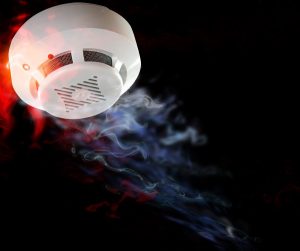An optical beam smoke detector is a device that uses a projected beam of light to detect smoke across large areas, typically as an indicator of fire. They are used to detect fires in buildings where standard point smoke detectors would either be uneconomical or restricted for use by the height of the building.
Beam smoke detectors can be an important component of a well-designed automatic fire alarm system. Because of their unique capabilities, they can overcome some of the problems and limitations of spot-type smoke detectors. A beam smoke detector can cover an area approximately 19,800 sq. ft. (330 sq. ft. x 60 sq. ft.), where as a spot-type detector can only cover an area approximately 900 sq. ft. (30 sq. ft. x 30 sq. ft.)
The principle on which an optical beam smoke detector works is light obscuration. Light blockage is often referred to as light obscuration or light extinction (LE). Light obscuration allows for high resolution particle sizing and counting down to 1 micron. The photosensitive element of the optical beam smoke detector sees light produced by the transmitter in any normal condition. The receiver is then calibrated to a preset sensitivity level based on a percentage of total obscuration. There are two general types of optical beam smoke detectors:
- End to End: Transmitter and receiver are mounted at either end of the protected area. A beam of infrared light is projected from the transmitter toward the receiver, and the signal strength received is monitored.
- Reflective: Transmitter and receiver are mounted in the same housing, and the beam is directed at the specifically designated reflector, mounted at the opposite end of the protected area. They require power to be supplied both to the transmitter and the receiver ends of the detector. This leads to longer wiring runs, and thus installation costs are greater than the reflective type device.
The type used will be dictated by the installation and environment conditions and constraints.
Whichever type you are designing, you can be assured that UKA is monitoring and working closely with engineers and manufacturing to ensure that the precision lenses for your equipment is of the highest quality. In the case of a fire, nothing should be left to chance.
Unlike point type optical smoke detectors, the response of beam smoke detectors is generally less sensitive to the type and color of smoke. Therefore, a beam smoke detector may be well suited to applications unsuitable for point optical smoke detectors, such as applications where the anticipated fire would produce black smoke. They do, however, require visible smoke to be effective.
An optical beam smoke detector is less susceptible to stray reflection as reflections go back to the transmitter. As a result, they can operate within a narrower gap left in the operating environment. In addition, they are generally compact and easily adapted into ‘aesthetic’ architectural designs.
While optical beam smoke detectors are not suited for all applications, they can be the detector of choice in many applications where spot-type detectors are not practical.